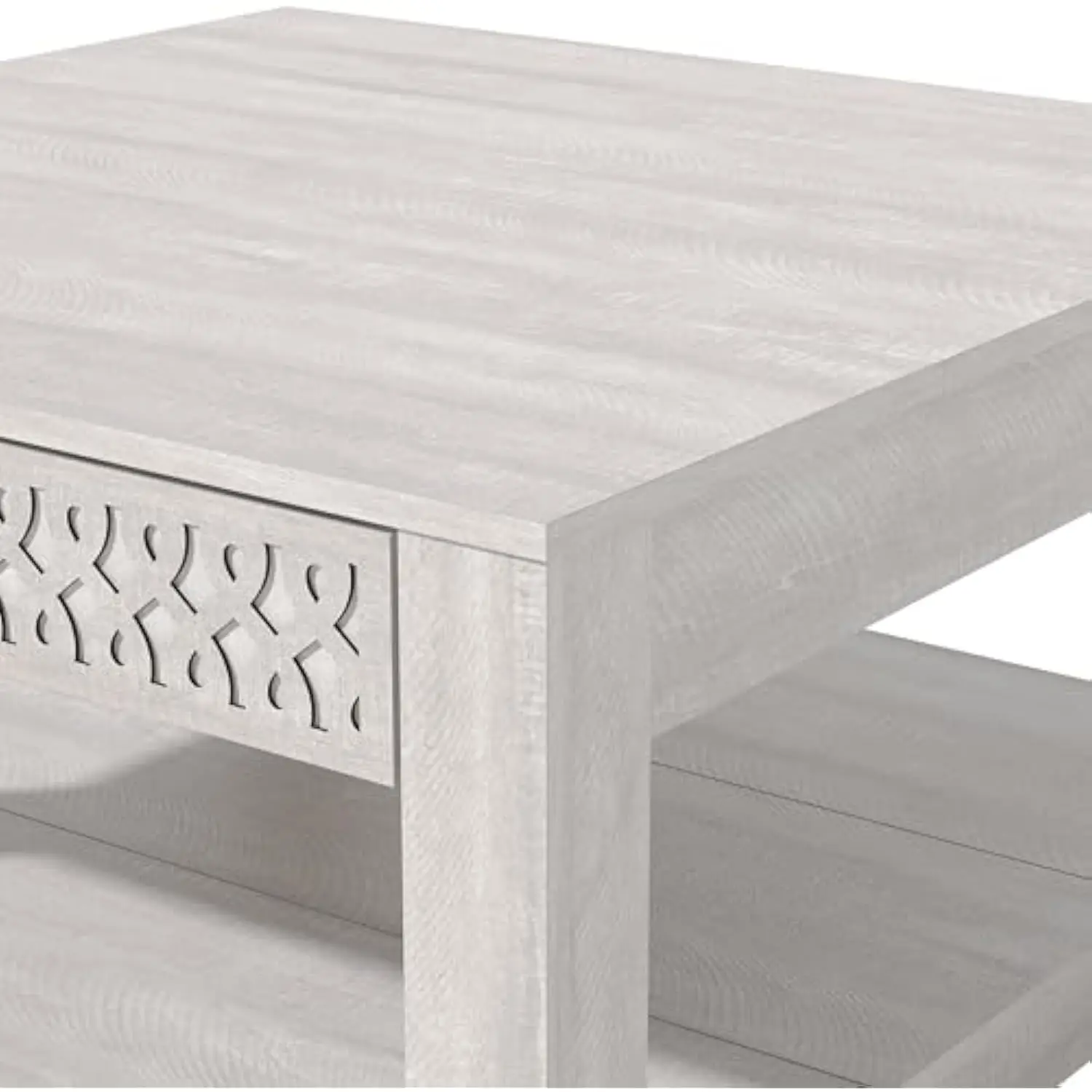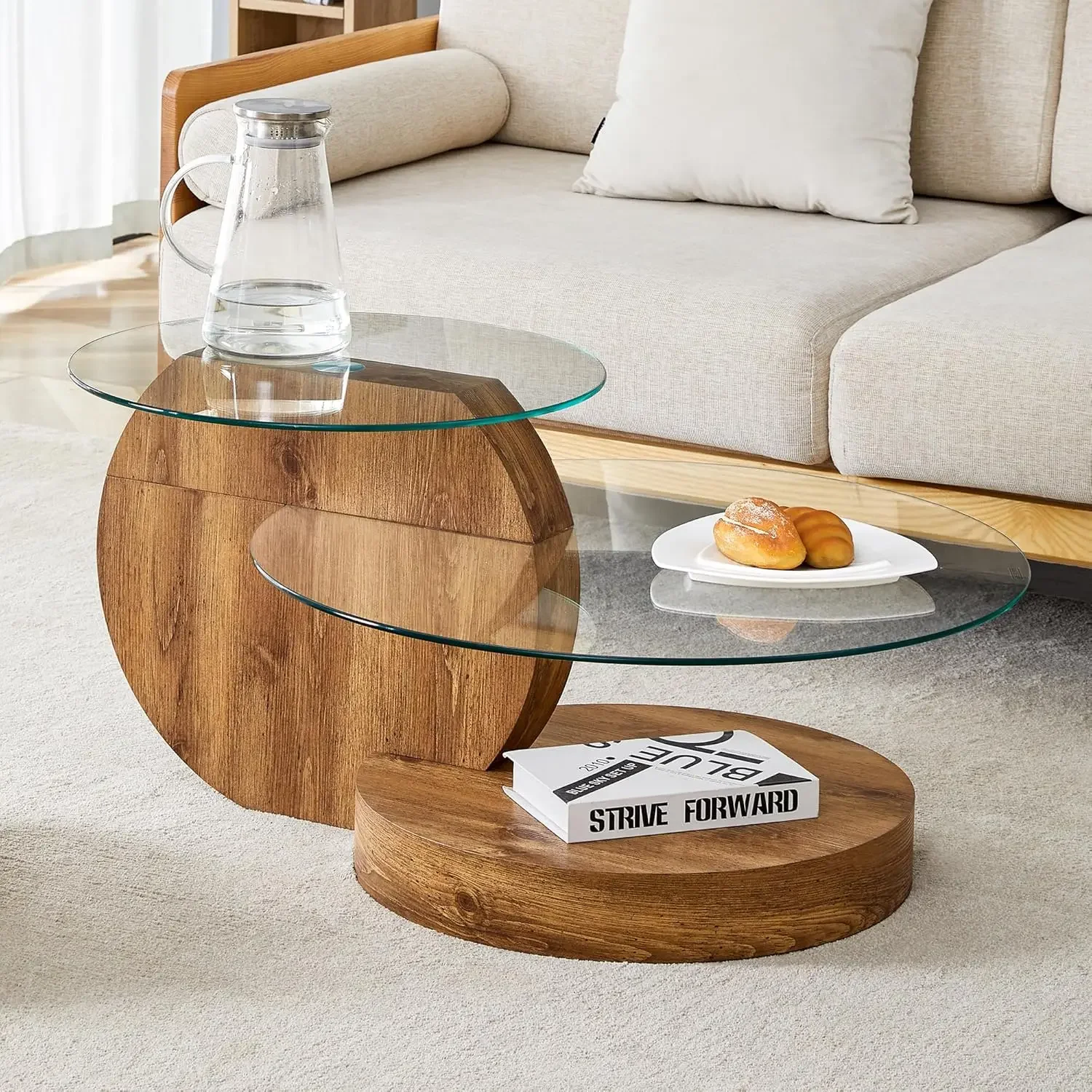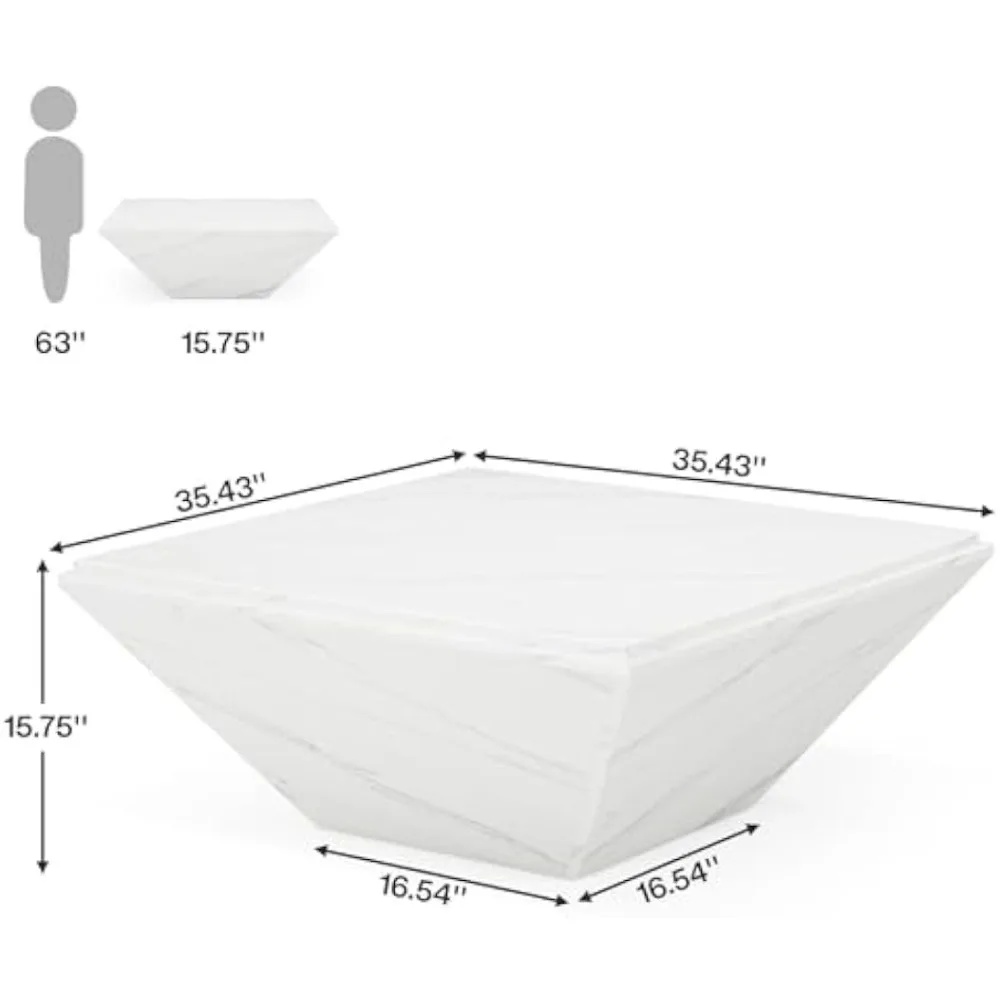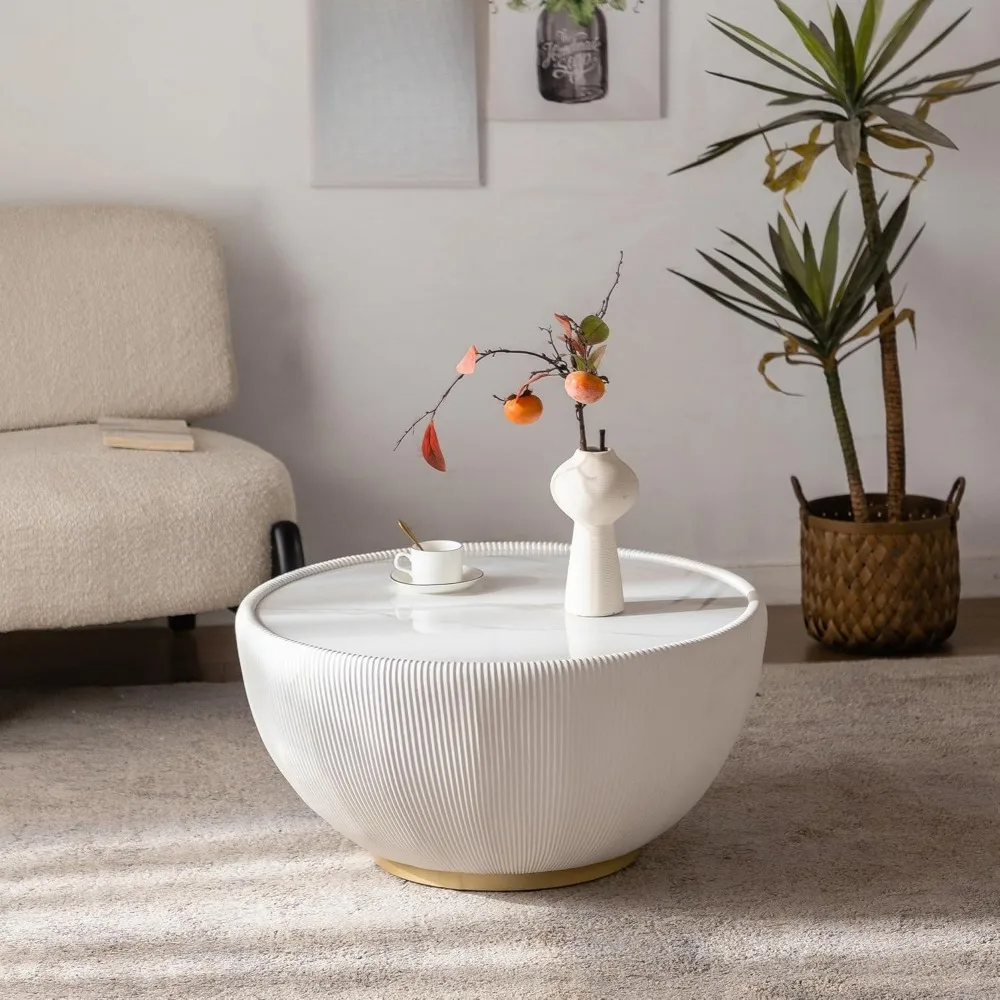Introduction: The Coffee Table Shape Decision and Why It Matters
Imagine this common scene: you’re standing in your living room, staring at the empty space between your sofa and chairs, trying to envision the perfect coffee table. Should you go with a sleek square design or an inviting round shape? This decision goes far beyond mere aesthetics – it fundamentally impacts how your entire living space functions and feels.
Coffee tables serve as both practical surfaces and visual anchors in our living rooms. They’re where we place drinks, display books, rest tired feet, and gather around for game nights. The shape you choose affects everything from traffic flow and space perception to functionality and overall room harmony.
When considering a coffee table, several factors come into play: the dimensions and layout of your space, your existing seating configuration, your lifestyle needs, and your preferred design style. These elements combine to create a complex decision that deserves thoughtful consideration.
Mid-century modern design philosophy, with its emphasis on balancing form with function, offers valuable guidance for this decision. The clean lines and intentional design of intelligent black mid-century coffee tables demonstrate how shape directly impacts both visual appeal and practical usability in your living space.
Understanding Your Space and Needs: Pre-Selection Analysis
Before deciding between square and round, take time to thoroughly assess your living space and requirements. Start by measuring the available area where your coffee table will reside. Design experts recommend that your coffee table should be approximately two-thirds the length of your sofa for proper proportion. Additionally, maintain clearance of 14-18 inches (35-45 cm) between the table and seating for comfortable leg room.
Consider your seating arrangement carefully:
– Standard straight sofas typically work well with either shape
– L-shaped sectionals often pair better with square or rectangular tables
– U-shaped configurations frequently benefit from round tables
– Multiple seating groups may require different approaches
Traffic flow mapping is essential – observe how people naturally move through the space. Where are the pathways? Will the table interrupt these flows? Also consider your lifestyle factors: households with young children might prefer rounded edges for safety, while those who entertain frequently might prioritize more surface area.
Your design aesthetic matters too. Various interior styles naturally favor certain shapes – mid-century modern design, for instance, embraces both geometric precision and organic curves. The way black coffee tables integrate with mid-century interiors demonstrates how shape contributes to the overall design cohesion of a space.
Round Coffee Tables: Advantages for Your Living Space Layout
Round coffee tables bring a gentle softness to living spaces, creating visual harmony through their curved edges and absence of sharp angles. Their flowing silhouette introduces an organic element that can balance rooms dominated by straight lines and rectangular furniture.
One of the primary benefits of round tables is their traffic flow enhancement. Without corners to navigate around, people naturally move more freely through the space. This improved circulation makes round tables particularly valuable in high-traffic areas or smaller rooms where movement pathways are limited. Safety studies suggest round tables can reduce minor injuries from bumps by nearly 30% compared to rectangular designs – a significant consideration for households with young children or elderly family members.
Round coffee tables excel at creating an illusion of space in compact rooms. Their smaller visual footprint and the way light flows around curved edges makes tight spaces feel more open and airy. The continuous edge also promotes more democratic social interaction, as people can gather equally around the circumference without anyone feeling positioned at a “head” or “end” of the table.
The gentle curves of mid-century modern round coffee tables work exceptionally well with U-shaped sectional arrangements, creating a natural conversation pit where everyone feels included in the social circle. Their shape mimics the natural way people gather, facing toward each other rather than in rows.
Square Coffee Tables: Benefits for Room Structure and Organization
Square coffee tables provide strong architectural presence in a living space, creating visual anchoring through their defined geometric shape. Their clean lines and right angles establish a sense of order and structure that many find inherently satisfying and grounding.
The practical advantage of square tables lies in their maximized surface area. Compared to round tables of the same width, square tables typically provide 15-20% more usable surface – a significant benefit for those who need space for books, remotes, games, or decorative objects. The straight edges also allow for more efficient use of the surface area, as items can be placed flush against corners without wasted space.
Square tables have a special complementary relationship with L-shaped sectional sofas. The right angles of both pieces create a cohesive geometric harmony, with the table’s corners often aligning perfectly with the sectional’s shape. This alignment creates a sense of intentional design that feels thoughtfully planned rather than randomly assembled.
In formal living rooms or spaces with symmetrical furniture arrangements, square tables contribute to the balanced feeling through their even proportions. When centered between facing sofas or in a traditional seating group, they provide equal accessibility from all sides while maintaining visual order.
The strong design statement made by mid-century modern square coffee tables works particularly well in spaces where you want the table to serve as a focal point rather than blending into the background.

Side-by-Side Comparison: Round vs. Square Coffee Table Layout Effects
| Layout Factor | Round Coffee Tables | Square Coffee Tables |
|---|---|---|
| Traffic Flow | Superior – no corners to navigate around | Good for structured pathways but corners can create obstacles |
| Child/Pet Safety | Excellent – no sharp corners or edges | Fair – corners pose potential hazard |
| Small Room Perception | Creates illusion of more space | Maximizes usable surface but can appear bulkier |
| Large Room Presence | May look undersized without proper scaling | Creates strong visual anchor |
| L-Shaped Sectional Compatibility | Fair – creates disconnect with angles | Excellent – geometric harmony |
| U-Shaped Seating Compatibility | Excellent – promotes equal conversation | Good – corners can create distance |
| Surface Utility | Less total area but no wasted corners | Maximum usable surface area |
| Visual Weight | Appears lighter and more floating | Creates stronger, grounded presence |
| Modern Minimalist Styles | Good – softens angular furniture | Excellent – reinforces clean lines |
| Traditional Styles | Good – adds unexpected contrast | Good – supports formal symmetry |
| Eclectic Styles | Excellent – adds organic element | Good – provides structure |
Beyond shape characteristics, material choices significantly impact visual impact. The decision between glass vs wood coffee tables can dramatically change how either shape integrates with your room’s overall design scheme.
Perfect Pairings: Matching Coffee Table Shape to Your Seating Configuration
Certain seating arrangements naturally complement specific coffee table shapes for maximum harmony and functionality:
L-Shaped Sectionals:
– Square tables generally work best, creating geometric continuity
– Position the table to align with the inner corner of the L
– Consider a larger square for expansive sectionals
– Ideal clearance: maintain 14-18 inches from each section of seating
U-Shaped Conversation Pits:
– Round tables excel here, creating natural flow
– The circle shape encourages equal participation in conversation
– Center the table precisely within the U-formation
– Scale the diameter to ensure accessibility from all seating positions
Traditional Sofa-and-Chairs Arrangements:
– Both shapes work well with balanced considerations
– For facing sofas: square reinforces formality, round softens the arrangement
– With offset chairs: consider how the shape guides visual focus
– Allow for balanced access from all seating positions
Floating Furniture Layouts:
– Prioritize traffic flow when furniture doesn’t hug walls
– Round tables create more flexible pathways around them
– Define conversation areas through table placement
– Consider how the shape impacts sightlines across the room
Understanding how to style black mid-century coffee tables with different seating arrangements can further enhance the cohesion between your table shape choice and overall room design.
Size, Proportion and Placement: Beyond Shape Considerations
While shape is crucial, size and proportion fundamentally impact how well your coffee table functions in your space. The industry-standard “two-thirds rule” suggests your coffee table should be approximately two-thirds the length of your primary sofa for visual balance. This proportion works regardless of whether you choose round or square.
Height relationship between table and seating is equally important. The ideal coffee table sits 1-2 inches (2.5-5 cm) lower than your sofa seat cushions – typically between 16-18 inches (40-45 cm) high based on standard sofa seat heights of 17-19 inches (43-48 cm). This height ensures comfortable reach while maintaining clear sightlines across the room.
Proper placement enhances both functionality and flow. Position your coffee table 14-18 inches (35-45 cm) from seating edges – close enough to reach comfortably but far enough for easy movement. In traffic areas, maintain minimum clearance paths of 24-30 inches (60-75 cm) around the table to prevent bottlenecks and awkward navigation.
Material choice significantly affects how the table’s shape reads visually. Glass tops visually lighten either shape, making them appear to float rather than dominate the space. This can be particularly valuable in smaller rooms where visual weight needs management. Conversely, solid wood or stone surfaces create stronger presence regardless of shape.
For more detailed guidance on placement options, exploring the complete guide to round coffee table placement provides specific scenarios and measurements for optimal arrangement.

Solving Layout Challenges: Shape Solutions for Difficult Spaces
Challenging living spaces often require strategic shape selection to overcome architectural limitations:
Small or Narrow Rooms:
Round tables generally work better in tight spaces, as their absence of corners creates more perceived floor space and easier navigation. In particularly narrow rooms, a smaller round table (30-36 inches/75-90 cm diameter) allows for better traffic flow than an equivalent square.
Open Concept Multi-Functional Areas:
When your living area blends with dining or other functional zones, table shape can help define distinct areas. A square table creates stronger visual boundaries between zones, while round shapes create smoother transitions between functional areas.
Rooms with Multiple Focal Points:
For spaces with competing focal points (fireplace, television, large windows), round tables help soften the directional pull, creating a more balanced visual experience. Their shape doesn’t reinforce any particular orientation in the room.
Awkward Architectural Features:
When dealing with irregular room shapes, angled walls, or intrusive columns, table shape can either minimize or intentionally complement these features. A round table tends to downplay architectural oddities by introducing an independent shape.
For maximum flexibility in challenging spaces, mid-century modern nesting coffee tables offer adaptable solutions that can be reconfigured as needed, combining the advantages of different shapes and sizes.
Special Considerations for Mid-Century Modern Design
Mid-century modern design principles offer valuable guidance when selecting coffee table shapes, as this design movement masterfully balanced geometric precision with organic curves. The philosophy behind mid-century furniture embraces both structural honesty and fluid functionality – qualities that manifest differently in square versus round tables.
Key mid-century characteristics that influence shape selection include:
Material Authenticity: Mid-century design celebrates natural materials in their honest form. Wood grain patterns flow differently across square versus round surfaces, creating distinct visual experiences.
Organic-Geometric Balance: While featuring clean lines, mid-century design often incorporates organic curves to maintain human connection – round tables express this principle inherently.
Functional Minimalism: Every element serves a purpose. The shape you choose should solve specific functional challenges in your space rather than simply making a style statement.
Visual Lightness: Many mid-century tables feature tapered legs or pedestal bases that create a floating quality. This lightness appears differently in square tables (which often have corner emphasis) versus round tables (with their continuous edge flow).
Understanding which styles go well with mid-century modern helps ensure your coffee table shape harmonizes with your broader design vision while maintaining authentic mid-century character.
Making Your Final Decision: Decision-Making Framework
To determine which coffee table shape best suits your specific situation, consider this step-by-step assessment framework:
Room Size Analysis
– Measure your available floor space
– Map existing traffic patterns
– Identify any tight spots or pinch pointsSeating Compatibility
– Evaluate your primary seating arrangement (L-shape, U-shape, traditional)
– Consider how the table edge will align with seating edges
– Determine ideal reach distances for all seated positionsLifestyle Requirements
– Safety needs (children, elderly family members)
– Entertainment style (casual vs. formal)
– Surface area requirements for typical activitiesAesthetic Priorities
– Desired visual weight (grounded vs. light)
– Existing geometric patterns in the space
– Balance of straight lines vs. curves in the roomDecision Priority
Ask yourself: Which factor matters most in my specific situation? If functionality ranks highest, your decision might differ from someone prioritizing visual impact.
Mid-Century Modern Solid Wood Coffee Tables, Mid-Century Modern Teak Coffee Tables
$879.95 Select options This product has multiple variants. The options may be chosen on the product pageMid-Century Modern Danish Coffee Tables, Mid-Century Modern Oval Coffee Tables, Mid-Century Modern Solid Wood Coffee Tables
$390.05 Select options This product has multiple variants. The options may be chosen on the product pageMid-Century Modern Coffee & End Table Sets, Mid-Century Modern Coffee Table Sets, Mid-Century Modern Oval Coffee Tables
Price range: $257.48 through $331.04 Select options This product has multiple variants. The options may be chosen on the product pageMid-Century Modern Glass Top Coffee Tables, Mid-Century Modern Glass Top Side & End Tables
$460.58 Select options This product has multiple variants. The options may be chosen on the product pageMid-Century Modern Glass Top Coffee Tables, Mid-Century Modern Vintage Coffee Tables, Mid-Century Modern Vintage Side & End Tables
$725.36 Select options This product has multiple variants. The options may be chosen on the product pageMid-Century Modern Lift Top Coffee Tables, Mid-Century Modern Square Coffee Tables
$454.73 Select options This product has multiple variants. The options may be chosen on the product page
Remember that the perfect coffee table should satisfy both practical needs and aesthetic desires. Our collection at Hearth Forms features options designed to meet diverse requirements while maintaining authentic mid-century character.

Exploring our complete mid-century modern coffee table collection can provide inspiration for finding the perfect shape and style for your unique living space.
Frequently Asked Questions About Coffee Table Shapes
Can I use a round table with an L-shaped sectional?
While square tables typically pair better with L-shaped sectionals, round tables can work effectively when positioned toward the open corner of the L rather than trying to align with the sectional’s angles. Consider a larger diameter round table to ensure adequate reach from all seating positions.
Will a square coffee table make my small room look cramped?
Not necessarily, though round tables generally create better visual flow in tight spaces. If you prefer a square table in a small room, consider one with a glass top or elevated on slender legs to reduce visual weight, and ensure proper clearance pathways (minimum 24 inches/60 cm) around all sides.
How do nesting tables fit into these shape considerations?
Nesting tables offer flexible solutions that can adapt to changing needs. Mixed-shape nesting sets (combining round and square tables) provide the benefits of both shapes for different situations, making them ideal for versatile spaces or frequent entertainers.
Should coffee table shape match other tables in the room?
Not necessarily. Contrasting shapes can create visual interest – for example, round side tables can beautifully complement a square coffee table. The key is maintaining consistent design language through materials, finishes, or other unifying elements rather than matching shapes exactly.
Does a glass top change the shape impact on a room?
Yes, significantly. Glass tops visually lighten either shape, reducing their visual footprint in the room. This material choice can make square tables appear less dominant and round tables almost ethereal, which is particularly valuable when decorating black mid-century coffee tables to prevent them from overwhelming the space.
Final Thoughts: Balancing Form and Function in Your Choice
The perfect coffee table shape ultimately depends on your unique space, lifestyle, and aesthetic preferences. While design principles can guide your decision, there’s no universally “correct” choice – only the shape that best serves your specific needs and enhances your living environment.
Remember that the most successful mid-century designs have endured precisely because they balance beauty with practicality. Your coffee table should do the same – functioning seamlessly in daily life while contributing to the visual harmony of your home. The principles outlined here apply whether you’re furnishing a spacious suburban living room or exploring small apartment coffee table ideas.
By thoughtfully analyzing your space requirements, considering traffic flow, evaluating your seating arrangement, and acknowledging your lifestyle needs, you can confidently select the coffee table shape that will enhance both the function and beauty of your living space for years to come.







